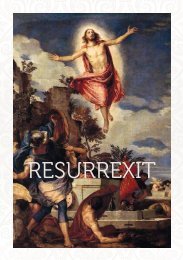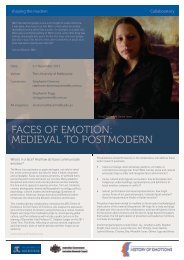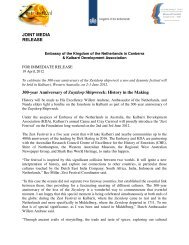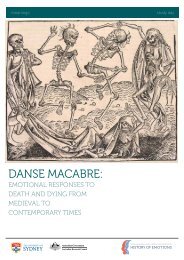Download our K-12 education pack - ARC Centre of Excellence for ...
Download our K-12 education pack - ARC Centre of Excellence for ...
Download our K-12 education pack - ARC Centre of Excellence for ...
You also want an ePaper? Increase the reach of your titles
YUMPU automatically turns print PDFs into web optimized ePapers that Google loves.
stories <strong>for</strong> teachers & students 2013<br />
Supporting Res<strong>our</strong>ces<br />
South Africa, Far from Home<br />
stories by winthrop pr<strong>of</strong>essor susan broomhall<br />
Starry nights: Cultures in the stars<br />
For all cultures, the stars above have held vital meanings about<br />
<strong>our</strong> hopes and dreams. Both the San and Khoikhoi peoples shared<br />
stories about the moon, which held deep significance <strong>for</strong> them and<br />
was a cause <strong>for</strong> ritual dances at the full and new moon.<br />
In 1861 the German linguist Willem Bleek came to the Cape<br />
where he met his new wife, and her sister-in-law, Lucy Lloyd.<br />
Together with Lucy, he began to study the language <strong>of</strong> the San<br />
people who spoke the now extinct /Xam language, and to collect<br />
their folklore and experiences. Bleek and Lloyd created the<br />
symbols to describe the click sounds <strong>of</strong> the indigenous<br />
languages that are still used today. These stories revealed much<br />
about how the San people understood the stars above them and<br />
the influence that these had over their life experiences.<br />
For example, Bleek and Lloyd were told that the moon was to be<br />
feared after game had been shot: ‘We may not look at the Moon,<br />
when we have shot game; <strong>for</strong>, we look, lowering <strong>our</strong> head, while<br />
we do not look up, towards the sky; while we are afraid <strong>of</strong> the<br />
Moon’s shining. It is that which we fear. For, <strong>our</strong> mothers used to<br />
tell us about it, that the Moon is not a good person, if we look at<br />
him.’ If they did, the moon might heal the game and then it would<br />
rise up and lead the hunter far away to a place where there was<br />
no water to survive.<br />
The stars themselves had been made by a girl a long, long time<br />
ago who threw wood ashes into the sky, making the Milky Way:<br />
‘the girl was the one who said that the Milky Way should give a<br />
little light <strong>for</strong> the people, that they might return home by night, in<br />
the middle <strong>of</strong> the night. For, the earth would not have been a<br />
little light, had not the Milky Way been there. It and the Stars.’<br />
The stars were also made by her. When she was angry with her<br />
mother <strong>for</strong> not giving her enough scented !huing roots to eat, she<br />
threw these too into the air. The red, older roots made the stars<br />
glowing red, while the white, young ones make the white stars. It<br />
was !Gaunu, the great star, who named the stars <strong>for</strong> the San<br />
people, singing their names to them. San people could also pray<br />
to particular stars to assist them, especially in hunting if they<br />
were hungry. As one man told Bleek, his grandfather had prayed<br />
to a star <strong>for</strong> help in hunting a springbok:<br />
Thou shalt give me thy heart, with which thou dost sit in plenty,<br />
thou shalt take my heart, – my heart, – with which I am<br />
desperately hungry. That I might also be full, like thee. For, I<br />
hunger. For, thou seemest to be satisfied [with food]; hence thou<br />
art not small. For, I am hungry. Thou shalt give me thy stomach,<br />
with which thou art satisfied. Thou shalt take my stomach, that<br />
thou mayst also hunger. Give thou me also thy arm, thou shalt<br />
take my arm, with which I do not kill. For, I miss my aim. Thou<br />
shalt give me thy arm. For, my arm which is here, I miss my aim<br />
with it.<br />
The star then took the arm with which he had missed the<br />
springbok.<br />
These were quite different ways to thinking about the stars to<br />
those <strong>of</strong> European navigators. However, they too relied on the<br />
stars <strong>for</strong> assistance in their j<strong>our</strong>neys. Mariners used an astrolabe<br />
and a mariner’s quadrant, from which they could measure the star<br />
Polaris at various key locations in order to tell their latitude. But<br />
Polaris is not visible after one crosses the equator into the<br />
southern hemisphere, as Portuguese navigators discovered on<br />
their j<strong>our</strong>neys down the African coast. They were able to adapt by<br />
using the position <strong>of</strong> the sun at noon. By the eighteenth century,<br />
mariners had developed other tools that were easier to use and<br />
hold steady on a rolling deck <strong>of</strong> a ship. They developed the sextant,<br />
which measured the angle between two objects (in navigation,<br />
usually a star in the sky and the horizon). Recording angles and<br />
times, they could track their position on a nautical chart.<br />
The Dutch contributed to the study <strong>of</strong> astronomy with scientists<br />
such as the brothers Christiaan and Constantijn Huygens, key<br />
figures in the development, use and observations through<br />
telescopes. In the eighteenth century, a series <strong>of</strong> scientists were<br />
sent from Europe to the Cape to make astronomical observations<br />
and records <strong>of</strong> the southern skies. After the British took over the<br />
Cape colony, they installed an Astronomer Royal at a new Cape <strong>of</strong><br />
Good Hope observatory. Discoveries made there included<br />
measuring the arc <strong>of</strong> the meridian and study <strong>of</strong> solar and stellar<br />
parallax. The scientist John Herschel arrived in 1834 to track the<br />
passing <strong>of</strong> Halley’s comet. Herschel, however, discovered other<br />
interests while he was there, not least the cataloguing <strong>of</strong> Cape<br />
Flora botanical specimens which he illustrated with his wife,<br />
Margaret. After he returned to England in 1838, he set about<br />
publishing his astronomical findings, which included giving<br />
names to seven <strong>of</strong> Saturn’s moons, Mimas, Enceladus, Tethys,<br />
Dione, Rhea, Titan, and Iapetus, names by which they are still<br />
known today.<br />
The geographic location <strong>of</strong> South Africa and Australia has given<br />
rise to a shared future with the world’s largest radio telescope,<br />
the Square Kilometre Array. In <strong>our</strong> remote regions, the view <strong>of</strong><br />
the Milky Way Galaxy is best and radio interference least. This<br />
project highlights the long-held importance <strong>of</strong> the stars <strong>for</strong><br />
humans across the world. Indigenous cultures have stories to<br />
tell about the heavens, bound to their cultures and heritage. The<br />
stars were also crucial to the ability <strong>of</strong> Europeans to navigate the<br />
oceans between these lands and beyond. The SKA project<br />
between <strong>our</strong> nations ensures that <strong>our</strong> futures will be no less<br />
linked than <strong>our</strong> pasts.<br />
FAR FROM HOME: ADVENTURES, TREKS, EXILES & MIGRATION<br />
51












